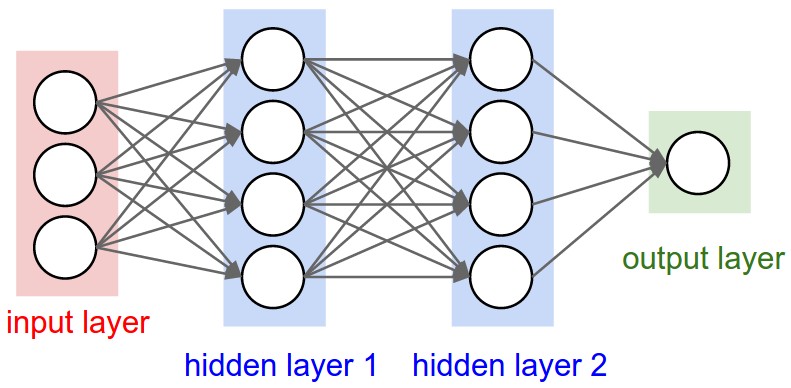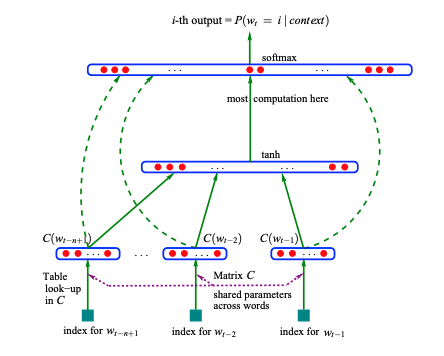#
multi-layer perceptron
Multi-layer perceptrons are the beginnings of a neural network. They consist of multiple layers of neurons, normalization layers, and more to create a neural network. It's important to have a solid understanding of what a neuron is before diving in here.
Since I'm very code inclined, here's the python that implements the following image:

The following code also uses the Value class from Back Propagation
class Neuron:
def __init__(self, nin):
self.w = [Value(random.uniform(-1,1)) for _ in range(nin)]
self.b = Value(random.uniform(-1,1))
def __call__(self, x):
# w * x + b
act = sum((wi*xi for wi, xi in zip(self.w, x)), self.b)
out = act.tanh()
return out
def parameters(self):
return self.w + [self.b]
class Layer:
def __init__(self, nin, nout):
self.neurons = [Neuron(nin) for _ in range(nout)]
def __call__(self, x):
outs = [n(x) for n in self.neurons]
return outs[0] if len(outs) == 1 else outs
def parameters(self):
return [p for neuron in self.neurons for p in neuron.parameters()]
class MLP:
def __init__(self, nin, nouts):
sz = [nin] + nouts
self.layers = [Layer(sz[i], sz[i+1]) for i in range(len(nouts))]
def __call__(self, x):
for layer in self.layers:
x = layer(x)
return x
def parameters(self):
return [p for layer in self.layers for p in layer.parameters()]
x = [2.0, 3.0, -1.0]
n = MLP(3, [4, 4, 1])
n(x)
#
single-layer perceptron
If we take the bi-gram example we can easily expand off of it to create a neural network with one layer of inputs and one layer of outputs and get roughly the same result.
import torch
words = open('names.txt', 'r').read().splitlines()
TOKEN='.'
chars = list(set(''.join(words)+TOKEN))
chars.sort()
stoi = dict([(ch, i) for i, ch in enumerate(chars)])
itos = dict([(i, ch) for ch, i in stoi.items()])
xs, ys = [], []
g = torch.Generator().manual_seed(2147483648)
for w in words:
chs = [TOKEN] + list(w) + [TOKEN]
for ch1, ch2 in zip(chs, chs[1:]):
ix1 = stoi[ch1]
ix2 = stoi[ch2]
xs.append(ix1)
ys.append(ix2)
xs = torch.tensor(xs)
ys = torch.tensor(ys)
W = torch.randn((27,27), generator=g, requires_grad=True)
xenc = torch.nn.functional.one_hot(xs, 27).float()
for _ in range(200):
logits = xenc @ W
counts = torch.exp(logits)
probs = counts / counts.sum(1, keepdim=True)
loss = (-probs[torch.arange(xs.nelement()), ys].log().mean())
print(loss)
W.grad = None
loss.backward()
W.data += -50 * W.gradAnd then we can sample from this simple neural network with the following
for _ in range(10):
out = []
ix = 0
while True:
xenc = torch.nn.functional.one_hot(torch.tensor([ix]), 27).float()
logits = xenc @ W
counts = logits.exp()
p = counts / counts.sum(1, keepdims=True)
ix = torch.multinomial(p, num_samples=1, replacement=True, generator=g).item()
out.append(itos[ix])
if ix == 0:
break
print(''.join(out))
#
xenc @ W?!
It took me awhile to get my head around exactly what was happening when you do logits = xenc @ W. When we did this with the bigram earlier, we could just get the probabilities for each input by calling prob[char]. We can actually do that as well here if we really felt like it with logits = W[ix][None, :], however as the math gets more complicated it's easier to stick to the matrix multiplication abstraction of that, which is xenc @ W. The [None, :] part takes care of converting the 27-length tensor to a 1x27 tensor.
#
multi-layer perceptron
A multi-layer perceptron builds off of the single-layer perceptron concept, but adds in the concepts of activation functions, normalization, and more.
The hardest thing for me to grasp in this is the embedding space. In the following code, you'll see we have a hyper parameter called EMBEDDING_SPACE which is 2. This means that for every character a-z. in our input, that character lives in 2d space and can be plotted with an x,y axis. When visualizing this, the groupings of these characters represent how closely the neural network thinks they're related.

When we increase the embedding space, we're essentially giving the neural network more dimensions to tune to gauge similarity between the input characters. So it can relate them amongst a variety of commonalities.
import torch
import torch.nn.functional as F
import matplotlib.pyplot as plt
%matplotlib inline
words = open('names.txt', 'r').read().splitlines()
g = torch.Generator().manual_seed(1)
[training_set, validation_set, test_set] = torch.utils.data.random_split(words, [.8 ,.1 ,.1], generator=g)
TOKEN='.'
CONTEXT_LENGTH=3
chars = list(set(''.join(words)+TOKEN))
chars.sort()
itos = dict([(i,s) for i, s in enumerate(chars)])
stoi = dict([s, i] for i, s in enumerate(chars))
def build_dataset(words):
xs = []
ys = []
for word in words:
context = [0]*CONTEXT_LENGTH
for i, ch in enumerate(word+TOKEN):
ix = stoi[ch]
xs.append(context)
ys.append(ix)
# print(f"{''.join(itos[i] for i in context)} -> " + ch)
context = context[1:]+[ix]
return xs, ys
xs, ys = build_dataset(training_set)
xsVal, ysVal = build_dataset(validation_set)
xsTest, ysTest = build_dataset(test_set)
LAYER_NEURONS = 300
CHARACTERS = len(chars)
EMBEDDING_SPACE = 2
NUM_INPUTS = len(xs)
X = torch.tensor(xs)
Y = torch.tensor(ys)
X_VAL = torch.tensor(xsVal)
Y_VAL = torch.tensor(ysVal)
C = torch.randn((CHARACTERS, EMBEDDING_SPACE), generator=g)
INPUT_DIMENSIONS = CONTEXT_LENGTH * EMBEDDING_SPACE
W1 = torch.randn((INPUT_DIMENSIONS, LAYER_NEURONS), generator=g)
b1 = torch.randn(LAYER_NEURONS, generator=g)
W2 = torch.randn((LAYER_NEURONS, CHARACTERS), generator=g)
b2 = torch.randn(CHARACTERS, generator=g)
parameters = [W1, b1, W2, b2, C]
num_params = sum([p.nelement() for p in parameters])
print(f"{num_params=}")
for p in parameters:
p.requires_grad = True
stepsi = []
lossi = []
BATCH_SIZE=32
for i in range(1000):
ix = torch.randint(0, X.shape[0], (BATCH_SIZE,))
# Forward pass
emb = C[X[ix]] # No calculation is happening here, we're simply fetching the embeddings for each input
h = torch.tanh(emb.view(-1, INPUT_DIMENSIONS) @ W1 + b1) # `.view` here transforms the NUM_INPUTS x CONTEXT_LENGTH x EMBEDDING_SPACE tensor into a NUM_INPUTS x (CONTEXT_LENGTH * EMBEDDING_SPACE) tensor so we can properly perform the dot product
logits = h @ W2 + b2
loss = F.cross_entropy(logits, torch.tensor(ys)[ix])
# Backward pass
for p in parameters:
p.grad = None
loss.backward()
lr = .1
for p in parameters:
p.data += -lr * p.grad
stepsi.append(i)
lossi.append(loss.item())
# Calculate loss with our validation set
plt.plot(stepsi, lossi)
emb = C[X_VAL]
h = torch.tanh(emb.view(-1, INPUT_DIMENSIONS) @ W1 + b1)
logits = h @ W2 + b2
val_loss = F.cross_entropy(logits, Y_VAL)
print(f"train_loss={loss.item()}")
print(f"val_loss={val_loss.item()}")
# Sample from the model
for _ in range(10):
out = []
context = [0] * CONTEXT_LENGTH
while True:
emb = C[torch.tensor([context])]
h = torch.tanh(emb.view(1, -1) @ W1 + b1)
logits = h @ W2 + b2
probs = torch.softmax(logits,1)
ix = torch.multinomial(probs, num_samples=1, replacement=True, generator=g).item()
context = context[1:]+[ix]
if ix == 0:
break
out.append(itos[ix])
print(''.join(out))import torch
import matplotlib.pyplot as plt
%matplotlib inline
torch.manual_seed(101)
words = open('names.txt', 'r').read().splitlines()
[training_set, validation_set, test_set] = torch.utils.data.random_split(words, [.8 ,.1 ,.1])
TOKEN='.'
chars = list(set(''.join(words)+TOKEN))
chars.sort()
itos = dict([(i,s) for i, s in enumerate(chars)])
stoi = dict([s, i] for i, s in enumerate(chars))
vocab_size = len(chars)
block_size = 8
def build_dataset(words):
xs = []
ys = []
for word in words:
context = [0]*block_size
for i, ch in enumerate(word+TOKEN):
ix = stoi[ch]
xs.append(context)
ys.append(ix)
# print(f"{''.join(itos[i] for i in context)} -> " + ch)
context = context[1:]+[ix]
return torch.tensor(xs), torch.tensor(ys)
Xtr, Ytr = build_dataset(training_set)
Xval, Yval = build_dataset(validation_set)
Xtest, YTest = build_dataset(test_set)
n_embd = 10
n_hidden = 200
model = torch.nn.Sequential(
torch.nn.Embedding(vocab_size, n_embd),
torch.nn.Flatten(),
torch.nn.Linear(n_embd * block_size, n_hidden, bias=False), torch.nn.BatchNorm1d(n_hidden), torch.nn.Tanh(),
torch.nn.Linear(n_hidden, n_hidden, bias=False), torch.nn.BatchNorm1d(n_hidden), torch.nn.Tanh(),
torch.nn.Linear(n_hidden, n_hidden, bias=False), torch.nn.BatchNorm1d(n_hidden), torch.nn.Tanh(),
torch.nn.Linear(n_hidden, n_hidden, bias=False), torch.nn.BatchNorm1d(n_hidden), torch.nn.Tanh(),
torch.nn.Linear(n_hidden, n_hidden, bias=False), torch.nn.BatchNorm1d(n_hidden), torch.nn.Tanh(),
torch.nn.Linear(n_hidden, n_hidden, bias=False), torch.nn.BatchNorm1d(n_hidden), torch.nn.Tanh(),
torch.nn.Linear(n_hidden, vocab_size)
)
with torch.no_grad():
model[-1].weight *= 0.1
print(sum(p.nelement() for p in model.parameters()))
# 224097
parameters = model.parameters()
for p in parameters:
p.requires_grad = True
max_steps = 50000
batch_size = 32
for i in range(max_steps):
ix = torch.randint(0, Xtr.shape[0], (batch_size, ))
Xb, Yb = Xtr[ix], Ytr[ix]
# forward pass
x = model(Xb)
loss = torch.nn.functional.cross_entropy(x, Yb)
for p in model.parameters():
p.grad = None
loss.backward()
lr = 0.1 if i<(max_steps*.75) else .01
for p in model.parameters():
p.data += -lr * p.grad
if i%(max_steps/10) == 0:
print(f"{i:7d}/{max_steps:7d}: loss={loss.item(): .4f}")
# 0/ 50000: loss= 3.2879
# 5000/ 50000: loss= 2.2665
# 10000/ 50000: loss= 1.8019
# 15000/ 50000: loss= 2.3069
# 20000/ 50000: loss= 1.9199
# 25000/ 50000: loss= 2.1590
# 30000/ 50000: loss= 1.8411
# 35000/ 50000: loss= 2.1169
# 40000/ 50000: loss= 1.9671
# 45000/ 50000: loss= 1.7272
# Enable evaluation mode
model.eval()
# evaluate the loss
@torch.no_grad() # this decorator disables gradient tracking inside pytorch
def split_loss(split):
x,y = {
'train': (Xtr, Ytr),
'val': (Xval, Yval),
'test': (Xtest, Ytest),
}[split]
logits = model(x)
loss = torch.nn.functional.cross_entropy(logits, y)
print(split, loss.item())
split_loss('train')
split_loss('val')
split_loss('test')
# train 1.9532647132873535
# val 2.0290515422821045
# test 2.030517816543579
num_examples = 10
for _ in range(num_examples):
CONTEXT = [0] * block_size
out = []
while True:
logits = model(torch.tensor([CONTEXT]))
probs = torch.softmax(logits, 1)
ix = torch.multinomial(probs, num_samples=1, replacement=True).item()
if ix == 0:
break
CONTEXT = CONTEXT[1:] + [ix]
out.append(ix)
print(''.join([itos[c] for c in out]))
# reemaria
# angeliel
# nyta
# torniss
# kaalyn
# celina
# sadari
# malayna
# gerykus
# aarisha
#
Critiques
One critique of MLPs is that the first step in the network crushes all of the data right off the bat, since all of the input embeddings are fed into a single layer. It might be better to work on smaller groupings of characters in multiple layers, so that they may more intelligently come up with relationships. More on that in wavenet An example of that is at the beginning of this article, and another example of that crushing can be seen below.
